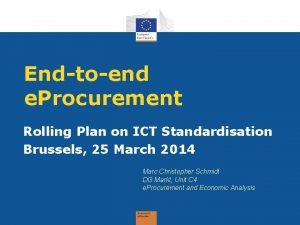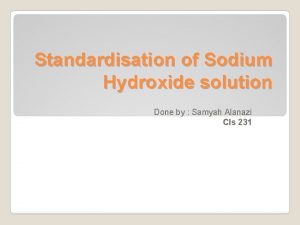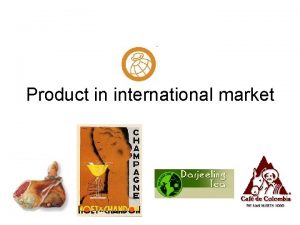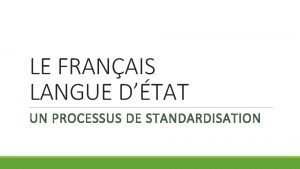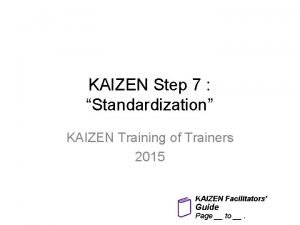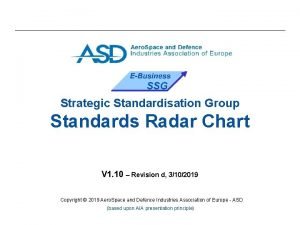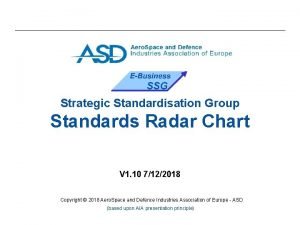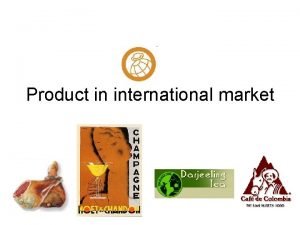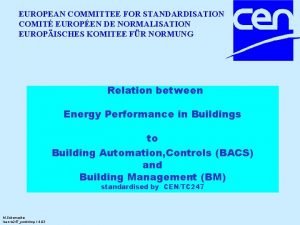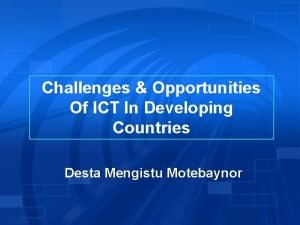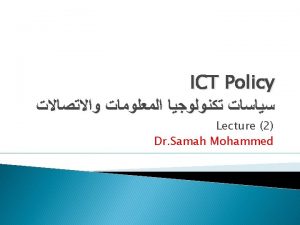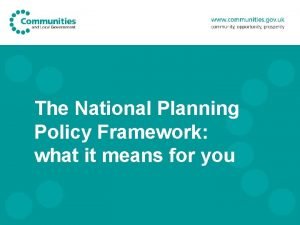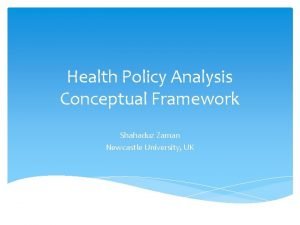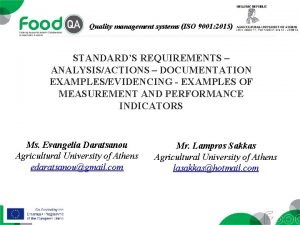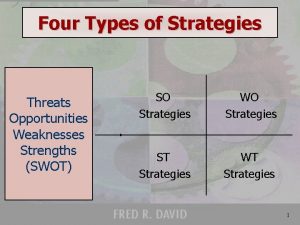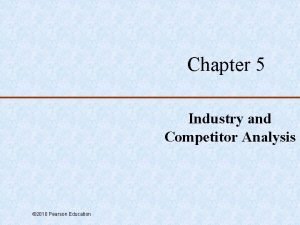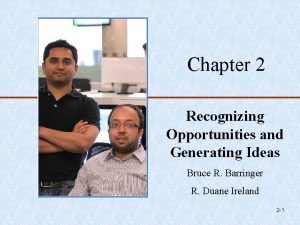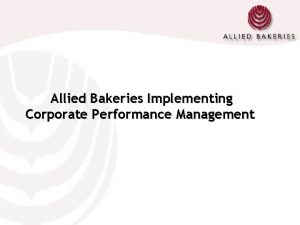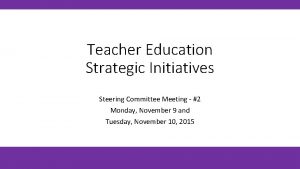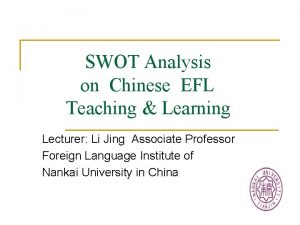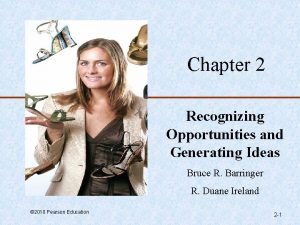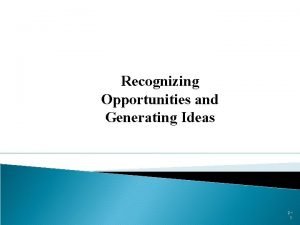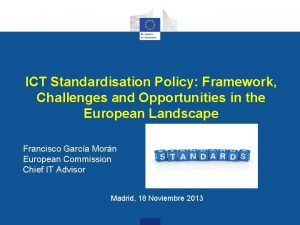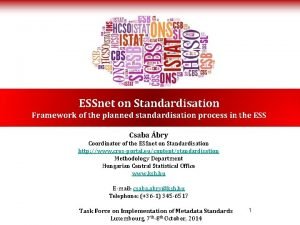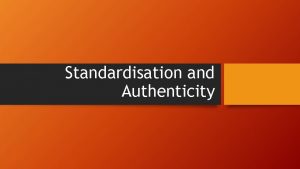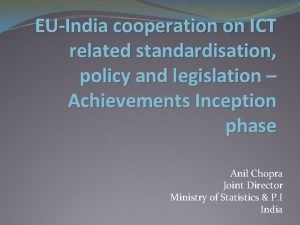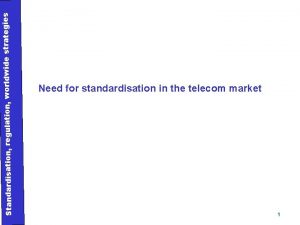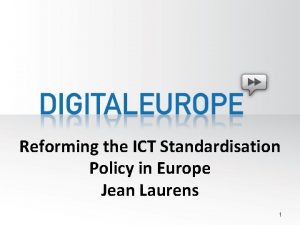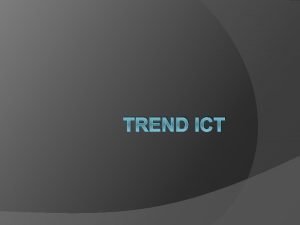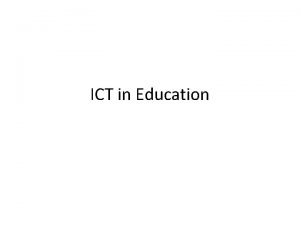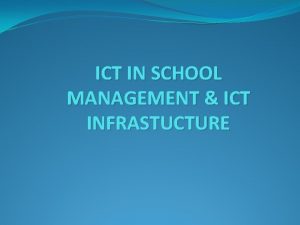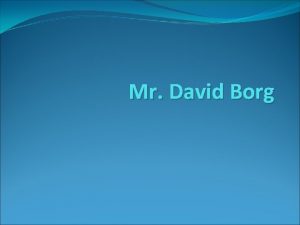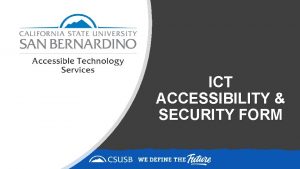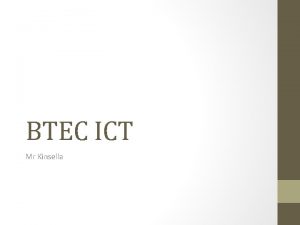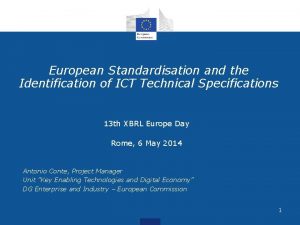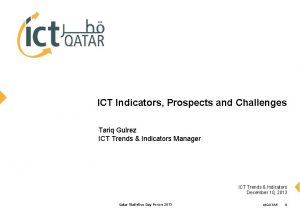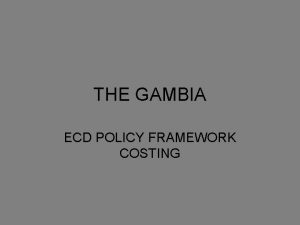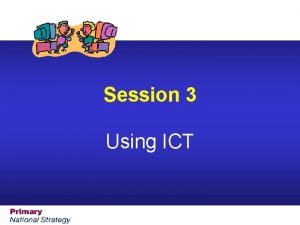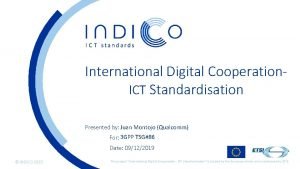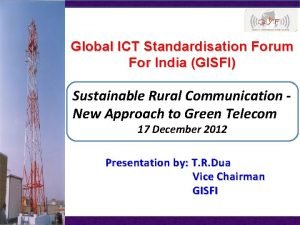ICT Standardisation Policy Framework Challenges and Opportunities in










![Regulation (EU) 1025/2012 [I] Consolidated legal basis for European standardisation which: • Repeals Decisions Regulation (EU) 1025/2012 [I] Consolidated legal basis for European standardisation which: • Repeals Decisions](https://slidetodoc.com/presentation_image_h/266bc68831ef99d5eb7adf37ad82412d/image-11.jpg)
![Regulation (EU) 1025/2012 [II] • Extends definitions and scope to services • Ensures cooperation Regulation (EU) 1025/2012 [II] • Extends definitions and scope to services • Ensures cooperation](https://slidetodoc.com/presentation_image_h/266bc68831ef99d5eb7adf37ad82412d/image-12.jpg)
![Regulation (EU) 1025/2012 [III] • Identification of ICT technical specifications for public procurement (Articles Regulation (EU) 1025/2012 [III] • Identification of ICT technical specifications for public procurement (Articles](https://slidetodoc.com/presentation_image_h/266bc68831ef99d5eb7adf37ad82412d/image-13.jpg)


















- Slides: 31

ICT Standardisation Policy: Framework, Challenges and Opportunities in the European Landscape Francisco García Morán European Commission Chief IT Advisor Luxembourg, 11 December 2013

“Every European Trust Veryfor fast and Enhancing Digital Research ICT Single social and e. Interoperability Digital” security Internet Market innovation skills challenges and standards Neelie Kroes Digital Single Market Interoper. & standards Trust & security Very fast Internet Research & Innovation Enhancing skills e- ICT for social challenges

Interoperability and standards Recognize and create more and better standards in Europe Make better use of these standards Ensure interoperability even in absence of standards

Interoperability and standards 2010 EIF 2011 stds e. Proc standards for e. Proc 2011 Malmö & Granada commitments, Regulation (EU) 1025/2012 application • New Rules for ICT standards • EIF • Guidance on • MS to apply EIF, ICT std MS to apply

Standards EU Regulation 1025/2012 (amending Directive 98/34)3 (the Standardisation Regulation) defines a ‘standard’ as ‘a technical specification adopted by a recognised standardisation body, for repeated or continuous application, with which compliance is not compulsory, and which is one of the following: • “international standard” means a standard adopted by an international standardisation body, • “European standard” means a standard adopted by a European standardisation organisation, • “harmonised standard” means a European standard adopted on the basis of a request made by the Commission for the application of Union harmonisation legislation; • “national standard” means a standard adopted by a national standardisation body; ’.

Open Specifications According to the European Interoperability Framework v 2 (COM(2010) 744), Open Specifications , which are essential for the setting up of Interoperability Agreements (the basis for the development of European Public Services) are characterised as follows 1. All stakeholders have the same possibility of contributing to the development of the specification and public review is part of the decision-making process; 2. The specification is available for everybody to study; 3. Intellectual Property Rights related to the specification are licensed on FRAND terms or on a royalty-free basis in a way that allows implementation in both proprietary and open source software

Standards are important • From research to production, from producer to consumer, from Europe to the rest of the world, European standards remove barriers, safeguard users, protect the environment, ensure interoperability, reduce costs and encourage competition. Studies show that standardisation adds between 0. 3% and 1% to GDP thereby helping industry towards the target of contributing 20% of the EU’s GDP by 2020

Standards are important

Legal Strategy Framework Organisational Semantical. Guidelines Infrastructure services Technical 9

Issues • A major part of ICT standardisation is done in global Fora & Consortia, outside the scope of the European standardisation system CEN/CENELEC/ETSI • These specifications are not directly available for referencing in public procurement However: • The Digital Agenda for Europe underlines the need for interoperability. Fora & Consortia specifications are expected to contribute • Fora & Consortia specifications need to be available for Europe
![Regulation EU 10252012 I Consolidated legal basis for European standardisation which Repeals Decisions Regulation (EU) 1025/2012 [I] Consolidated legal basis for European standardisation which: • Repeals Decisions](https://slidetodoc.com/presentation_image_h/266bc68831ef99d5eb7adf37ad82412d/image-11.jpg)
Regulation (EU) 1025/2012 [I] Consolidated legal basis for European standardisation which: • Repeals Decisions 87/95/EC and 1673/2006/EC • Amends several Directives, including Directive 98/34/EC • Entered into force on 1/1/2013
![Regulation EU 10252012 II Extends definitions and scope to services Ensures cooperation Regulation (EU) 1025/2012 [II] • Extends definitions and scope to services • Ensures cooperation](https://slidetodoc.com/presentation_image_h/266bc68831ef99d5eb7adf37ad82412d/image-12.jpg)
Regulation (EU) 1025/2012 [II] • Extends definitions and scope to services • Ensures cooperation between NSB on draft standards and work programmes (Articles 3 -4) • Increases stakeholder participation • An obligation for ESOs (Article 5) • Financing of other European organisations (Article 16, criteria in Annex III)
![Regulation EU 10252012 III Identification of ICT technical specifications for public procurement Articles Regulation (EU) 1025/2012 [III] • Identification of ICT technical specifications for public procurement (Articles](https://slidetodoc.com/presentation_image_h/266bc68831ef99d5eb7adf37ad82412d/image-13.jpg)
Regulation (EU) 1025/2012 [III] • Identification of ICT technical specifications for public procurement (Articles 13 and 14) • Proposals from Member States or Commission • Multi-Stakeholder Platform to advise • Criteria for identification (Annex II) • Committee to assist the Commission (Article 22)

European Multi-stakeholder Platform on ICT Standardisation • • Mandate for three years Participants : Member States, SDOs, industry, SMEs, societal organisations Observers on case by case basis Advice on implementation of ICT standardisation policy, work programme Advice on selection and evaluation process in view of recognition of ICT technical specifications Chair and secretariat: Commission services Kick-off meeting: 26 March 2012

European Multi-stakeholder Platform on ICT Standardisation • 1. The platform shall be composed of up to 67 members. • 2. The members shall be the national authorities of Member States and EFTA countries and organisations representing ICT standardisation stakeholders appointed by the Commission as follows: • a) Up to 18 organisations representing industry, small and medium-sized enterprises and societal stakeholders, • b) Up to 14 European and international standardisation bodies and other nonprofit making organisations which are professional societies, industry or trade associations or other membership organisations active in Europe that within their area of expertise develop standards in the field of ICT. • 3. The members referred to in 2(a) and (b) shall be appointed by the Directors-General of DG Enterprise and Industry and DG Information Society and Media on behalf of the Commission from relevant stakeholder organisations with the aim of achieving a balanced representation taking account of the tasks and expertise required.

The Rolling Plan for ICT Standardisation • Successor of the 2010 -2013 ICT Standardisation Work Programme • Renamed to avoid confusion with the annual union work programme • Rolling plan = multiannual • Living document = no defined duration • Drafted by the Commission • Adviced by the Multi-stakeholder Platform on ICT Standardisation • Addressed to all ICT stakeholders (not only ESOs)

Content of the Rolling Plan Actions to support policies : • Linked to a EU policy • Direct involvement of a defined Commission Service • Examples: Intelligent Transport, e. Health, e. Invoicing Actions to support general interoperability: • Not linked to a specific policy • Not linked to a specific Commission Service • Example: testing events

Structure of the entries 1. Policy area title and description 2. Legislation and policy documents A. EU Legislation B. Additional information from Member States 3. Memeber States and Stakeholders input 4. Standardization needs to implement legilation and policy A. Comission perspective B. Member States and Stakeholders perspective 5. Related on-going standardization and research activities A. At EU level B. Other relevant work 6. Proposed NEW standardization actions A. Proposed standars development B. Proposed other activities around standardization

Entry for XBRL (draft) 1/2 1. Policy area title and description A. e. Business need for unified definitions, identification and codification for information B. XBRL definition 2. Legislation and policy documents A. EU legislation and policy documents 1. 2. 3. Small Business Act (2008/2237 (INI) COM(2011)0684, COM(2011)0683 Documents from the Legal Affairs Committee of the EP B. Additional information in MS 1. Netherlands Standard Business Reporting 3. MS and Stakeholder input A. B. MS: No specific or additional input to this version Stakeholders: No specific or addtional input to this version 4. Standardization needs A. B. EC perspective: MS and Stakeholders: No specific or additional input to this version

Entry for XBRL (draft) 2/2 5. Related on-going standardization and research activities A. At EU level 1. 2. 3. 4. XBRL specs and related resources International Reporting Standards XBRL taxonomies and related resources XBRL resources for EU banking and insurance supervision CEN Workshop "XBRL-Improving Transparency in Financial and Business Reporting" B. Other relevant work : No specific or additional input to this version 6. Proposed new standardization activities A. Proposed standard developments : No specific or additional input to this version B. Proposed other activities around standardization 1. 2. Depending on results of CEN workshop, launch a Basisc Survey to MS : Initiatives, resources and position on XBRL and its fit to EU Regulatory Accounting Practices Coordinated EU input to the global XBRL standardization process (International Fiancial Reporting Standards taxonomy)

How does it work? Standards for EU procurement European Standardization Organizations ETSI CENELEC Multistakeholder platform ICT fora and consortia Community and Stakeholders

Work Plan 2013 on ICT Standardisation • • • e. Health RFID e. Skills and e. Learning e. Procurement and e. Catalogues e. Invoicing On-Line Dispute Resolution (ODR) for e. Commerce The Internet of Things (Io. T) Electronic identification and trust services including electronic signatures Card, internet and mobile payments Intelligent Transport Systems (ITS)

MSP Results Standards proposed by MSP to the EC on 17/10/2013 for approval (1 Q 2014) for official use in public procurement 1. W 3 C XML : Extensible Mark-up Language 2. ECMA-402: ECMAScript Internationalization API Specification 3. IETF LDAPv 3: Lightweight Directory Access Protocol Version 3 4. IETF DNSSEC: Domain Name System Security Extensions 5. IETF DKIM: Domain. Keys Identified Mail

Conclusion

ISA work on developing common specifications for public administrations ADMS and federation of semantic assets repositories Core Vocabularies DCAT Application Profile

ADMS implementation Since January 2013 ADMS-based federation of semantic standards repositories Catalogue of semantic standards • Semantic standards are described using ADMS • Features simple and advanced search of semantic standards • 2000+ semantic standards from 25 repositories are currently searchable through Joinup (Sep. 2013)

ISA work on developing common specifications for public administrations ADMS and federation of semantic assets repositories Core Vocabularies DCAT Application Profile

Core Vocabularies Core vocabularies Simplified, re-usable, generic and extensible data models that capture the fundamental characteristics of a data entity in a context-neutral fashion.

Core Vocabularies specs Core Vocabularies are available through the Join. up platform since April 2012 Available in …and Core Vocabularies have been endorsed by the member states in the context of the ISA Coordination Group, May 2012 License ISA Open Metadata License v 1. 1 https: //joinup. ec. europa. eu/category/licence/isa-open-metadata-licence-v 11

Standardisation Information and Contact Web sites: http: //ec. europa. eu/enterprise/policies/europeanstandards/standardisation-policy/index_en. htm http: //ec. europa. eu/enterprise/sectors/ict/standard s/index_en. htm http: //ec. europa. eu/isa/ e-Mail: entr-ket-and-ict@ec. europa. eu francisco. garcia-moran@ec. europa. eu

Thank you !!!
 Rolling plan for ict standardisation
Rolling plan for ict standardisation Media information opportunities and challenges
Media information opportunities and challenges Greater bay area opportunities and challenges
Greater bay area opportunities and challenges Standardisation of sodium hydroxide
Standardisation of sodium hydroxide Product adaptation examples
Product adaptation examples Processus de standardisation
Processus de standardisation Step 7 training
Step 7 training Property standardisation group
Property standardisation group Property standardisation group
Property standardisation group Standardisation vs adaptation in international marketing
Standardisation vs adaptation in international marketing European committee for standardisation
European committee for standardisation Ict challenges
Ict challenges Define ict policy
Define ict policy Theoretical framework example
Theoretical framework example What is national planning policy framework
What is national planning policy framework Policy triangle framework
Policy triangle framework Dispositional framework vs regulatory framework
Dispositional framework vs regulatory framework Climate change theoretical framework
Climate change theoretical framework Conceptual framework theoretical framework
Conceptual framework theoretical framework Dispositional framework vs regulatory framework
Dispositional framework vs regulatory framework Theoretical framework example
Theoretical framework example Actions to address risks and opportunities
Actions to address risks and opportunities Swotwo
Swotwo Competitive analysis grid example
Competitive analysis grid example New entry exploitation
New entry exploitation Trends and opportunities examples
Trends and opportunities examples Factbranch
Factbranch Swot analysis of a teacher
Swot analysis of a teacher Opportunities and threats of a teacher
Opportunities and threats of a teacher An opportunity has four essential qualities it is
An opportunity has four essential qualities it is Career opportunities in biotechnology and drug development
Career opportunities in biotechnology and drug development Recognizing opportunities and generating ideas
Recognizing opportunities and generating ideas
